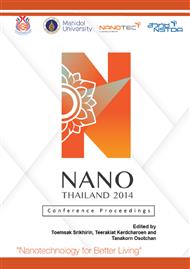[1]
M. Ali Abbasi, Z. H. Ibupoto, M. Hussain, M. Willander, The fabrication of white light-emitting diodes using the n-ZnO/NiO/p-GaN heterojunction with enhanced luminescence, Nanoscale Research Letters. 8 (2013) 320-325.
DOI: 10.1186/1556-276x-8-320
Google Scholar
[2]
F. Schuster, B. Laumer, R. R. Zamani, J. R. Morante, M. Stutzmann, p-GaN/n-ZnO Heterojunction Nanowires: Optoelectronic Properties and the Role of Interface Polarity, ACS Nano, 8 (5) (2014) 4376–4384.
DOI: 10.1021/nn406134e
Google Scholar
[3]
J. B. Baxter, A. M. Walker, K. V. Ommering, E. S. Aydi, Synthesis and characterization of ZnO nanowires and their integration into dye-sensitized solar cells, Nanotechnology, 17 (2006).
DOI: 10.1088/0957-4484/17/11/s13
Google Scholar
[4]
Y. Wang, X. L. Xu, W. Y. Xie, Z. B. Wang, Free-standing ZnO-CuO composite nanowire array films and their gas sensing properties, Nanotechnology, 22: 32 (2011) 325704.
DOI: 10.1088/0957-4484/22/32/325704
Google Scholar
[5]
J. Yi, J. M. Lee, and W. Park, Vertically aligned ZnO nanorods and graphene hybrid architectures for high-sensitive flexible gas sensors, Sensors and Actuators, B vol. 155, (2011) 264-269.
DOI: 10.1016/j.snb.2010.12.033
Google Scholar
[6]
S. Hullavarad, N. Hullavarad, and D. Look., Persistent Photoconductivity Studies in Nanostructured ZnO UV Sensor, Nanoscale Res Lett., vol. 4. (2009) 1421-1427.
DOI: 10.1007/s11671-009-9414-7
Google Scholar
[7]
M. Q. Israr, J. R. Sadaf, and O. Nur, Chemically fashioned ZnO nanowalls and their potential application for potentiometric cholesterol biosensor, Applied Physics Letters, 98, (2011) 253705.
DOI: 10.1063/1.3599583
Google Scholar
[8]
S. Noothongkaew, S. Pukird, W. Sukkabot, B. Kasemporn, Ki-Seok An, Zinc Oxide Nanostructures Synthesized by Thermal Oxidation of Zinc Powder on Si Substrate, Applied Mechanics and Materials Vol. 328 (2013) 710-714.
DOI: 10.4028/www.scientific.net/amm.328.710
Google Scholar
[9]
F. Fleischhaker, V. Wloka, and I. Henniga, ZnO based field-effect transistors (FETs): solution-processable at low temperatures on flexible substrates, J. Mater. Chem., 20 (2010) 6622-6625.
DOI: 10.1039/c0jm01477j
Google Scholar
[10]
J. Goldberger, J. Sirbuly, and P. Yang ZnO Nanowire Transistors, J. Phys. Chem. B, 109 (1), (2005) 9–14.
Google Scholar
[11]
P. C. Chang, Z. Fan, C. J. Chien1, High-performance ZnO nanowire field effect transistors, Appl. Phys. Lett. vol. 89, (2006) 133113.
DOI: 10.1063/1.2948901
Google Scholar
[12]
N. Elamin, A. Elsanousi, Synthesis of ZnO Nanostructures and their Photocatalytic Activity, Journal of Applied and Industrial Sciences, vol. 1 (2013) 32-35.
Google Scholar
[13]
K. S. Yu, J. Y. Shi, Z. L. Zhang, Y. Liang, Synthesis Characterization and Photocatalysis of ZnO and Er-Doped ZnO, Hindawi Publishing Corporation Journal of Nanomaterials, (2013).
DOI: 10.1155/2013/372951
Google Scholar
[14]
Q. Peng and Y. Qin., Zinc Oxide Nanowire Solar Cells Resemble Caterpillars, Chaper Nanowies.
Google Scholar
[15]
Z. Liang, R. Gao, J. L. Lan, et al., Growth of vertically aligned ZnO nanowalls for inverted polymer solar cells, Solar Energy Materials and Solar Cells, vol. 117 (2013) 34-40.
DOI: 10.1016/j.solmat.2013.05.019
Google Scholar
[16]
Z. Wu, L. Qin, and Q. Pan, Fabrication and electrochemical behavior of flower-like ZnO-CoO-C nanowall arrays as anodes for lithium-ion batteries, Journal of Alloys and Compound., vol. 509, (2011) 9207-9213.
DOI: 10.1016/j.jallcom.2011.06.114
Google Scholar
[17]
Q. An, Y. Xin, K. Huo, Xun Cai, P. K. Chu, Corrosion behavior of ZnO nanosheets on brass substrate in NaCl solutions, Materials Chemistry and Physics 115 (2009) 439–443.
DOI: 10.1016/j.matchemphys.2009.01.001
Google Scholar
[18]
S. Noothongkaew, S. Pukird, W. Sukkabot, Ki-Seok An, Zinc Oxide Nano walls Synthesized by Chemical Vapor Deposition, Key Engineering Materials Vol. 608 (2014)127-131.
DOI: 10.4028/www.scientific.net/kem.608.127
Google Scholar
[19]
M. J. Zheng, L.D. Zhang, G.H. Li, W. Z Shen, Fabrication and optical properties of large-scale uniform zinc oxide nanowire arrays by one-step electrochemical deposition technique, Chem. Phys. Lett. 363, (2002) 123.
DOI: 10.1016/s0009-2614(02)01106-5
Google Scholar
[20]
S. Ohara, T. Mousavand, M. Umetsu, Hydrothermal synthesis of fine zinc oxide particles under supercritical conditions, Solid state Ionics 172 (2004) 261-264.
DOI: 10.1016/j.ssi.2004.02.044
Google Scholar
[21]
W. T. Chiou, W. Y. Wu, J. M. Ting, Growth of single crystal ZnO nanowires using sputter deposition, Diamond and Related Materials, 12 (2003) 1841-1844.
DOI: 10.1016/s0925-9635(03)00274-7
Google Scholar
[22]
Y. W. Heo, V. Varadarajan, M. Kaufman, K. Kim, Site-specific growth of ZnO nanorods using catalysis driven molecular beam epitaxy, Applied Physics Letters, 81 (2002) 3046-3048.
DOI: 10.1063/1.1512829
Google Scholar
[23]
H. Zhang, J. Feng, J. Wang, M. Zhang, Preparation of ZnO nanorods through wet chemical method, Materials Letters, 61 (2007) 5202-5205.
DOI: 10.1016/j.matlet.2007.04.030
Google Scholar
[24]
J. L. Yang, S. J. An, W. I. Park, G. C. Yi, W. Choi, Photocatalysis using ZnO thin films and nanoneedles grown by metal-organic chemical vapor deposition, Advanced Materials, 16: 18 (2004) 1661-1664.
DOI: 10.1002/adma.200306673
Google Scholar
[25]
J. Zhang, D. Gao, G. Yang, Synthesis and magnetic properties of Zr dopedZnO Nanoparticles, Nanoscale Research Letters, 6 (2011) 587-593.
Google Scholar
[26]
M.G. Gong, Y.Z. Long, X.L. Xu, H.D. Zhang and B. Sun, Synthesis Superhydrophobicity, Enhanced Photoluminescence and Gas Sensing Properties of ZnO Nanowires, Nanowires-Recent Advances, chapter 5, 77-100.
DOI: 10.5772/52586
Google Scholar
[27]
H. Zhang, J. Feng, J. Wang, M. Zhang, Preparation of ZnO nanorods through wet chemical method, Materials Letters, 61 (2007) 2202-5205.
DOI: 10.1016/j.matlet.2007.04.030
Google Scholar
[28]
W. K. Hsieh, and K. J. Chen, Effect of Ag film thickness on the crystallization mechanism and photoluminescenxe properties of ZnO/Ag nanoflower arrays, Applied Surface Science, 258 (2012) 8049-8054.
DOI: 10.1016/j.apsusc.2012.04.170
Google Scholar
[29]
J. Liu, S. Xie, and X. Wang, et al., Homoepitaxial regrowth habits of ZnO nanowireArrays, Nanoscale Research Letters. 6 (2011) 619-625.
Google Scholar
[30]
M. Ahmad and J. Zhu, ZnO based advanced functional nanostructures: synthesis, properties and applications, J. Mater. Chem., 21 (2011) 599-614.
DOI: 10.1039/c0jm01645d
Google Scholar
[31]
H. Zhou, G. Fang, N. Liu, X. Zhao, Ultraviolet photodetectors based on ZnO nanorods-seed layer effect and metal oxide modifying layer effect, Nanoscale Research Letters, 6 (2011) 147.
DOI: 10.1186/1556-276x-6-147
Google Scholar


